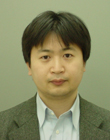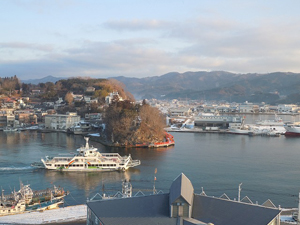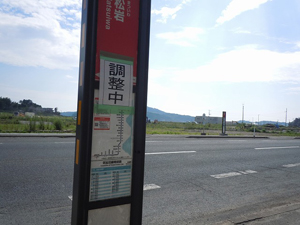Top>Research>Legal issues in disaster reconstruction seen from cases on the Sanriku Coast (Part II)
 Index
Index

Hideo Nakazawa [profile]
Education Course
Legal issues in disaster reconstruction seen from cases on the Sanriku Coast (Part II)
Hideo Nakazawa
Professor of Political Sociology and Community and Regional Sociology, Faculty of Law, Chuo University
(Continued from Part I. Part I dealt with deficiencies in disaster related laws and property rights and compensation.)
4. Disaster prevention and town planning
Friction surrounding seawalls is a major feature of the reconstruction process from this disaster. The view of the inner harbour at Kesennuma, which is protected by Oshima, a natural seawall, is spectacular (photograph 3), and there are even visitors who say that it reminds them of southern Italy. This inner harbour bristled with fishing port facilities, shipyards, and a marine product processing plant, producing scenery and lifestyles fitting of the name Fish Town. However, the Miyagi prefectural government, on the back of calls to "save lives", plans to construct TP (elevation above sea level with Tokyo Bay as the standard. Accordingly, that is not the exact height of the structures.) 7.2m seawalls on the coastline throughout the prefecture without allowing any exemptions. Since the announcement of the plan, the opposition shown by the citizens of Kesennuma has been considerably fierce, and due to this issue remaining after a year and a half, progress has not been made on the reconstruction of the center of the town. Because the Miyagi government shows no signs of backing down, in Kesennuma, an extraordinary move was performed, a competition calling for inner harbour reconstruction plans was held with the Obayashi Corporation proposed "floating seawall" at the entrance to the harbour plan chosen in an attempt to avoid the construction of a seawall encircling the inner harbour. This attempt failed, with Miyagi Governor Murai stating, "the safety of floating seawalls hasn't been proven." A group of volunteers from the city has started up the seawall study committee in August 2012, and is trying to find out if there is a way to reach a compromise with the Miyagi government. This kind of friction is also taking place in Rikuzen-Takata City.

Photograph 3 The stunning scenery of the Kesennuma inner harbour
Because the height of the seawall is the basis of the town planning, until this matter settles down, a future image of the centre of Fish Town cannot be drawn up, and because the marine products processing plant and related industries cannot be positioned, the employment situation continues to deteriorate. The town, where the population outflow continues unabated, is suspended in a mood of stagnation. Even so, many citizens (especially business leaders) believe that compromising with the prefecture and building a giant seawall in the inner harbour would be akin to an act of suicide for the Kesennuma fishing and tourist industries.
However, legally, a major portion of the Kesennuma coastline is owned by the Prefectural Civil Engineering Office and Port Office or the national government (Fisheries Agency and Forestry Agency), and in administrative law terms, there is no room for municipal involvement. At the seawall study committee held at the Kesennuma City Hall on August 16, a resident asked, "When people from the prefectural and national governments open their mouths they are talking about agreement from the residents, who, and by what means are they collating this agreement?" Not a single participant from the prefecture (Civil Engineering Office) or government (Forestry Agency) had a response. It makes one ponder the issues surrounding municipal and regional laws when a local government tries to paint an overall picture but cannot.
5. Intergovernment relations
As seen above, through the whole reconstruction process, wondering what happened to decentralization seemed to sap the strength out of the situation universally. Deputy mayoral positions on the Sanriku coast are mainly filled up by people sent from the national (especially the Ministry of Land, Infrastructure and Transport) and prefectural governments. To typify the seawall case, most of the time, we are made to realize that the relationship between the state and city, or prefecture and city is not equal. The national government wields overwhelming financial power and authority, and the mediating prefectural governments interpret set systems for their own convenience, a composition that leaves the municipalities at their mercy. Because the municipalities are swamped with everyday affairs, they have no power in reserve to raise questions themselves. Support staff from other municipalities have come in to help, but that does not always function effectively. That is because in regions like the Sanriku coast, which bear historical reasons of each community where social and blood ties are strong, there is a limit to where outsiders can impose adjustments on policy and interest.
On top of that, the further you enter into the reconstruction phase, the stronger the feeling becomes that the information being reported from the mass media in Tokyo is alienated from the realities on the Sanriku coast. For example, this summer the central media made unused funds from the reconstruction budget the target of their attacks and stressed that work should be "accelerated", but when looking at the above mentioned reality of the situation in Kesennuma, the cause of the lack of progress is because too much power lies with the prefectural government. It appears that reality based on that kind of concrete system isn't being seen from Tokyo. From the festival of Olympic broadcasting, bringing up the memory of "Kesennuma born Kenta Chida bringing his silver medal home" is the best they can do. Although there is another long story in the steady involvement in fencing by the Chida family and the people of Kesennuma, Tokyoites only get to see it in an easy to understand diagram.
That is why, even in the aspect of the media, intergovernmental relations are thought-provoking. The repercussions brought about by the nationwide integration of newspapers and television policies from the 1920s to 1950s were extremely large but, thankfully, many local media outlets remained on the Sanriku coast, and there are also some prime locations where you can observe cases that had no side effects. Miyagi's prefectural newspaper is the Kahoku Shinpo, and the Iwate Nichinichi in Iwate, but in the daily lives of residents on the coast, these prefectural newspapers alone are not enough. The city newspapers (Tokai Shinpo in Rikuzen Takata and Sanriku Shinpo in Kesennuma) are read every morning, and they are structured so you can follow economic and social movements.
Even in regards to public transport, intergovernment relations give you something to think about. In Kesennuma, I had the chance to reread the work of Tsuneichi Miyamoto (Kesennuma Oshima is home to Miyamoto's "Fishery Library" which is run by the Kanagawa University Institute for the Study of Japanese Folklore, as Miyamoto folklore has a close connection to Kesennuma. This is also a Sanriku regional resource which has difficulty in attracting attention) and, the second volume in the collection of his works Chuo to Chiho [Central and Regional Governments] is overflowing with accounts that are even relevant today. In here, Miyamoto touches upon how the people of Suo Oshima persuaded the then Ministry of Transport with figures showing that, compared to the amount of taxes paid, the amount going back into to the community was extremely low, and finally became the only island outside of Honshu, Kyushu, Shikoku and Hokkaido, to have Japanese National Rail bus service running. Why is it that taxes paid by local communities don't seem to make their way to remote places? The flow of Kesennuma's riches and human resources to Sendai and Tokyo is a serious matter. In regards to the circulation of wealth, shouldn't there be more debate on public funds not just ending in a short-lived road construction (Sanriku Road), but also for the continued support of public transport (photograph 4 The Kesennuma Line temporarily restored for a bus system)? As similar fishing towns, there is something to be learned here for the battles of Iwate's Sanriku Railway and Chiba's Choshi Railway.

Photograph 4 The Kesennuma Line temporarily restored for a bus system
6. New Public Commons and university
In regards to the field combining NPOs, NGOs and volunteer groups, also called the "New Public Commons", many legal issues are remaining. The duplicity of NPOs and NGOs has been pointed out (Norihiro Nihei), funds have been gathered for groups that are active on an international level, but for groups that don't fall into that category, the reality is that many are pulling out due to fundraising difficulties. Even when saying groups at international level group, the reality is that the Japan Foundation, a group established through a partial diversion of ODA funds, stands out and has an especially strong voice in the Iwate Prefecture area. Unfortunately, Japan's "New Public Commons" has not been able to free itself from relying on government funding. On the other hand, Citizen's Fund, a system that circulates small amounts of money (Mutual Aid Financial Systems Brought About By the Great East Japan Earthquake (https://www.yomiuri.co.jp/adv/chuo/opinion/20110808.htm) has gained attention but even in the initial structure, or organization of general investment, there must still be room for ideas. For example, as a result of declining coverage in the disaster area, the amount of funds procured by the citizen's fund "Security Disaster Zone Support Fund"(http://oen.securite.jp/) has dropped off.
In the beginning of part I, I stated that "there are no easy to understand jobs for first time volunteers remaining." However, that doesn't mean that the volunteers have disappeared from affected areas. NPO, NGO and university organizations are continuing their activities. The volunteers here, are not those who are generally misunderstood to "provide labor to accommodate simple needs". They are closer to the original meaning of the word "volunteer", people who are willing to think about what they can do to revive the community. To avoid misunderstanding, I would like to call them "community revival volunteers", but if anyone has a better idea, please let me know.
What universities can do from now on is, more than anything, contribute to the community through research. In the case of Rikuzen Takata, Professor Tanishita of the Faculty of Science and Engineering has proposed a green network scheme based on local folklore (https://www.yomiuri.co.jp/adv/chuo/dy/opinion/20120507.htm).In Kesennuma, an idea has been floated to develop "Kesennuma Network University", a project involving local people and uncovering community resources in coordination with several universities.
If it is a one-off open lecture that may be realized immediately if a number of volunteers can be gathered. However, if both the instructors and learners do not decide upon goals, as well as lack in organization and continuity in order to seriously develop local human resources, it will not continue for long. It would be good if the structures such as appropriately attaching credit recognition functions to these far afield lectures, and conferring titles such as "Sanriku Regional Resource Coordinator" to citizens who continually participate and write a graduation thesis, are continued. Just because it is a disaster zone, because lecturers will not continue to work for free forever, it won't lead to true revitalization. The damage will be forgotten, and the locals are moving toward independence. Because this will be developed as official university business, a new monetary flow and employment will result (simply speaking, collected tuition fees will be put towards employment and expenses for maintaining the university's Kesennuma satellite campus.) I believe it would be good to see models such as in England, where universities support regional employment, become more commonplace in Japan.
(Postscript: According to the September 22, 2012 edition of Kahoku Shinpo, Miyagi University and Hyogo University of Teacher Education will start a joint education program for a period of 10 years. Partners in the program will be Miyagi Prefecture, Osaki City, Shiraishi City, Kesennuma City and Minami-Sanriku Town. Both universities will create a problem detecting and solving type curriculum for nurturing "city planners". The plan depicted in 6. above has first been realized by Miyagi University, which has stood out in being active in the disaster area but, in any case, it would be nice to see many university resources joined together in this kind of platform.)
References
- From this year, Chuo University's volunteer activities on the Sanriku coast are continuing in the form of student organizations (http://www.chuo-u.ac.jp/chuo-u/eminfo/index_j.html#eminfo04).Those results will be continually published in Gakuin Jiho, Hakumon Chuo and Kusa no Midori etc. We are also continuing collections of alumni association donations to support the volunteer activities of the students (http://www.chuo-u.ac.jp/chuo-u/news/contents_j.html?suffix=k&visit=11&mode=vst&topics=15902).
- Hideo Nakazawa
Professor of Political Sociology and Community and Regional Sociology, Faculty of Law, Chuo University - Born in Tokyo. Graduated from the University of Tokyo in 1994. Received doctorate (sociology) from the University of Tokyo in 2001. Started his current position in 2009 after working as a lecturer at the Faculty of Social Information, Sapporo Gakuin University, and associate professor at the Faculty of Letters, Chiba University. Is a member of The Japan Sociological Society and the Japan Association of Regional and Community Studies. Major publications include, Juumin Tohyou Undou To Rookaru Rejiimu [Local Referendum Movements and the Local Regime] (Harvest-sha), dealing with nuclear issues in Niigata Prefecture, and Kankyou No Shakaigaku [Environmental Sociology] (coauthored, Yuhikaku), on a wide range of themes including waste, nuclear energy and environmental culture. The former title was awarded the 5th Japan Sociological Society Encouragement Award and the 32nd Tokyo Institute for Municipal Research Fujita Award.
- Research Activities as a Member of Research Fellowship for Young Scientists (DC1), Japan Society for the Promotion of Science (JSPS) Shuma Tsurumi
- Important Factors for Innovation in Payment Services Nobuhiko Sugiura
- Beyond the Concepts of Fellow Citizens and Foreigners— To Achieve SDGs Goal 10 “Reduce Inequality Within and Among Countries” Rika Lee
- Diary of Struggles in Cambodia Fumie Fukuoka
- How Can We Measure Learning Ability?
—Analysis of a Competency Self-Assessment Questionnaire— Yu Saito / Yoko Neha - The Making of the Movie Kirakira Megane








